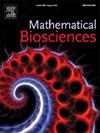Epidemic spreading on biological evolution networks
IF 1.8
4区 数学
Q2 BIOLOGY
引用次数: 0
Abstract
The spread of epidemics is closely related to network structure. In reality, network structure will change over time with the departure or employment of many individuals. Mathematical models can not only be used to simulate the evolution of networks, but also to better analyze the changes in the spread of epidemics. In the present work, we propose two mathematical models of evolution networks with the addition and deletion of nodes to analyze epidemic spread on homogeneous and heterogeneous networks. We discuss various factors affecting the spread of epidemics when the evolution network reaches a steady state, including the number of new nodes and their initial degree, the deletion rate of nodes, and so on. The results show that in homogeneous networks, the epidemic threshold first increases and then decreases, while in heterogeneous networks, the epidemic threshold increases or decreases under certain conditions. It provides many measures to improve the epidemic threshold and slow down the spread of epidemics.
传染病在生物进化网络上传播。
传染病的传播与网络结构密切相关。在现实中,随着时间的推移,网络结构会随着许多人的离开或就业而发生变化。数学模型不仅可以用来模拟网络的演变,还可以更好地分析流行病传播的变化。在本工作中,我们提出了两个具有添加和删除节点的进化网络数学模型来分析同质和异质网络上的流行病传播。我们讨论了当进化网络达到稳态时影响流行病传播的各种因素,包括新节点的数量及其初始度、节点的删除率等。结果表明,在同质网络中,流行阈值先增大后减小,而在异质网络中,流行阈值在一定条件下增大或减小。它为提高疫情阈值、减缓疫情蔓延提供了许多措施。
本文章由计算机程序翻译,如有差异,请以英文原文为准。
求助全文
约1分钟内获得全文
求助全文
来源期刊

Mathematical Biosciences
生物-生物学
CiteScore
7.50
自引率
2.30%
发文量
67
审稿时长
18 days
期刊介绍:
Mathematical Biosciences publishes work providing new concepts or new understanding of biological systems using mathematical models, or methodological articles likely to find application to multiple biological systems. Papers are expected to present a major research finding of broad significance for the biological sciences, or mathematical biology. Mathematical Biosciences welcomes original research articles, letters, reviews and perspectives.
 求助内容:
求助内容: 应助结果提醒方式:
应助结果提醒方式:


